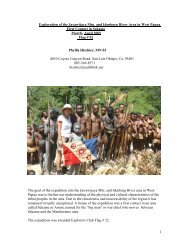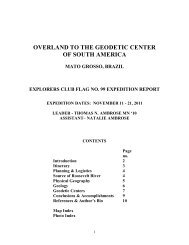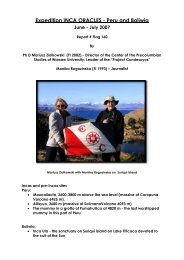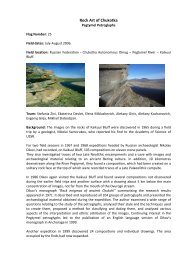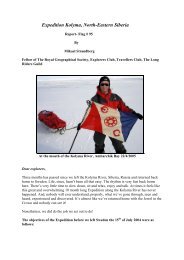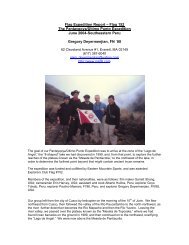the explorers journal - The Explorers Club
the explorers journal - The Explorers Club
the explorers journal - The Explorers Club
You also want an ePaper? Increase the reach of your titles
YUMPU automatically turns print PDFs into web optimized ePapers that Google loves.
EXPLORATION NEWS<br />
On January 16, New York City<br />
artist, adventurer, and sailor<br />
Reid Stowe accomplished his<br />
goal of remaining at sea for<br />
1,000 days (2 years, 7 months<br />
and 4 days) without re-supply<br />
or touching land while aboard<br />
his 70-foot gaff-rigged schooner<br />
Anne, and in <strong>the</strong> process<br />
broke four world records.<br />
Stowe, 57, and his girlfriend<br />
and first mate, Soanya<br />
Ahmad, departed Hoboken,<br />
New Jersey, on April 21,<br />
2007, to attempt <strong>the</strong> longest<br />
sea voyage in history. <strong>The</strong>y set<br />
sail with three years’ worth of<br />
food, solar panels for energy,<br />
large tarps to catch rainwater,<br />
a laptop, an Iridium satellite<br />
telephone, and a Metocean<br />
tracking unit that would verify<br />
<strong>the</strong> path of <strong>the</strong> 1000-day voyage<br />
(see Google map at<br />
www.1000days.net)<br />
As Stowe and Ahmad<br />
entered <strong>the</strong> rough Sou<strong>the</strong>rn<br />
Ocean on day 305, Ahmad<br />
10<br />
S a i l o r S t o w e B r e a k s R e c o r d<br />
longest voyage without landfall<br />
experienced debilitating<br />
nausea, which was believed<br />
to be seasickness. She was<br />
transferred off <strong>the</strong> coast of<br />
Australia to ano<strong>the</strong>r boat that<br />
ferried her to back to land<br />
where it was confirmed she<br />
was pregnant. She returned<br />
to New York to have her son,<br />
Darshen, now 19 months old.<br />
Prior to Stowe’s voyage, <strong>the</strong><br />
longest continuous time on<br />
record was 657 days held by<br />
Australian, Jon Sanders after<br />
his triple circumnavigation in<br />
1987. As Stowe approached<br />
Sanders’ solo record on day<br />
964, Sanders wrote, “Well<br />
done Reid. Good luck, mate.”<br />
Last month at an event<br />
for his friends and supporters<br />
held at <strong>the</strong> South Street<br />
Seaport Museum, Stowe,<br />
whose computer has been<br />
disabled by moisture, called<br />
in by sat phone to explain that<br />
instead of returning during <strong>the</strong><br />
stormy winter months, he has<br />
decided to sail with <strong>the</strong> variable<br />
winds and currents of <strong>the</strong><br />
Atlantic Doldrums, and plans<br />
to return on June 17, 2010, at<br />
which time he will have been<br />
ship-bound for an astounding<br />
1,151 days.<br />
“I’m nervous about coming<br />
back and dealing with <strong>the</strong> real<br />
world and things I haven’t had<br />
to think about for three years,”<br />
says Stowe. “None<strong>the</strong>less,<br />
I feel lucky to have accomplished<br />
this impossible goal<br />
I’ve set for myself.”<br />
F i r s t a n t a r c t i c<br />
p l a n e f o u n d<br />
Mawson craft buried in <strong>the</strong> ice<br />
Australian researchers have<br />
found <strong>the</strong> remains of <strong>the</strong><br />
first airplane ever taken to<br />
Antarctica, 99 years after<br />
it was brought <strong>the</strong>re by<br />
Australian polar explorer and<br />
geologist Douglas Mawson.<br />
Mawson led two expeditions<br />
to Antarctica in <strong>the</strong> early<br />
1900s, on <strong>the</strong> first one bringing<br />
along a single-propeller<br />
Vickers plane. <strong>The</strong> wings of<br />
<strong>the</strong> plane, built in 1911, had<br />
been damaged in a crash<br />
before <strong>the</strong> expedition, but<br />
Mawson hoped to use it as<br />
a kind of motorized sled suring<br />
<strong>the</strong> 1911–1914 Australian<br />
Antarctic Expedition.<br />
Unfortunately, <strong>the</strong> plane’s<br />
engine could not withstand<br />
<strong>the</strong> extreme temperatures and<br />
it was eventually abandoned.<br />
<strong>The</strong> plane, <strong>the</strong> first of its kind<br />
from France’s Vickers factory,<br />
had not been seen since <strong>the</strong><br />
mid-1970s when researchers<br />
photographed <strong>the</strong> steel<br />
fuselage nearly encased<br />
in ice. <strong>The</strong> Mawson’s Huts<br />
photo courtesy Reid Stowe.



